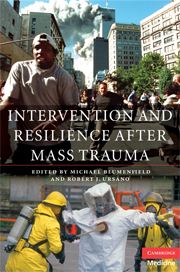Book contents
- Frontmatter
- Contents
- List of contributors
- Foreword by Joseph T. English
- Preface
- 1 Systems, science, and populations: Effective early mental health intervention following mass trauma: the roles of government, clinicians, and communities
- 2 Factors in the development of community resilience to disasters
- 3 Psychological first aid
- 4 Acute stress disorder and early interventions after trauma
- 5 The role of pharmacotherapy in early interventions
- 6 Should culture considerations influence early intervention?
- 7 Resilience is the default: how not to miss it
- 8 Epilog: Early intervention for individuals and communities: planning for the future while meeting present needs
- Index
- References
7 - Resilience is the default: how not to miss it
- Frontmatter
- Contents
- List of contributors
- Foreword by Joseph T. English
- Preface
- 1 Systems, science, and populations: Effective early mental health intervention following mass trauma: the roles of government, clinicians, and communities
- 2 Factors in the development of community resilience to disasters
- 3 Psychological first aid
- 4 Acute stress disorder and early interventions after trauma
- 5 The role of pharmacotherapy in early interventions
- 6 Should culture considerations influence early intervention?
- 7 Resilience is the default: how not to miss it
- 8 Epilog: Early intervention for individuals and communities: planning for the future while meeting present needs
- Index
- References
Summary
Introduction
Recent studies of potentially traumatic events show apparently paradoxical findings; for example, during the 2001–2004 wave of terror, Bleich et al. (2003) found simultaneous reporting of optimism and of being depressed in a nationally representative sample of Israeli citizens. Shalev et al. (2006) described normal (that is, peacetime) levels of distress in a substantial majority of civilians who were directly exposed by terrorist acts. Galea et al. (2003) and Silver et al. (2002) found limited prevalence of residual distress following the September 11, 2001 attack on New York.
These and similar findings have been construed as reflecting “resilience.” Resilience, in this context, is the absence of an expected bad outcome, such as general distress, depression, or post-traumatic stress disorder (PTSD). Following that logic, after an event of the magnitude of the September 11 attacks on New York, or following exposure to terrorist acts, one is either “traumatized” or “resilient.”
Assuming that either traumatic response or resilience is the only option has a cost. Like every reduction of complex realities into dichotomies, using this assumption in research, or even as a manner of speech, entails significant loss of information. It may therefore misclassify or mischaracterize survivors at both ends. Most importantly, construing “PTSD” and “resilience” as the two opposing poles of the same continuum is an assumption that requires further validation.
- Type
- Chapter
- Information
- Intervention and Resilience after Mass Trauma , pp. 149 - 172Publisher: Cambridge University PressPrint publication year: 2000
References
- 6
- Cited by

